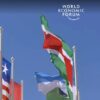Environmental, social and geopolitical crises made 2022 an eventful year, with much of the focus on energy (security) and extreme weather events.
We also saw advances on climate-related spending, biodiversity and sustainable finance regulation.
While the wider sustainability field will continue to hold investor attention in 2023, Alex Bernhardt, Global Head of Sustainability Research at BNP Paribas Asset Management, discusses three key areas with ESG Insight today.
Energy crisis
While it was initially uncertain what impact the energy crisis – fuelled by the war in Ukraine and the rapid post-pandemic economic rebound – would have on net zero commitments, it’s now clear that it has started to push down carbon emissions, Bernhardt explained.
Carbon Brief has estimated that the EU’s CO2 emissions from energy use dropped by 5% over August, September and October 2022 from the same period in 2021.
“This may be attributed to rising fossil fuel prices that have forced households and industries to reduce electricity and gas use,” Bernhardt continued.
The energy crisis is also driving an acceleration in installations of renewable power – the world is now expected to add the same amount of renewable power in the next five years as it did in the previous 20, according to the International Energy Agency (IEA).
“This build-out would be some 30% higher than the level of growth the IEA forecast in 2021,” he noted.
“The energy crisis is driving an acceleration in installations of renewable power.”
Alex Bernhardt
Government policies should contribute to this, Bernhardt stated.
The EU’s REPowerEU plan is to cut the bloc’s reliance on Russian fossil fuels and speed up the energy transition. The US Inflation Reduction Act includes USD 369 billion in incentives to boost clean energy supplies and investment in green technology
Moreover, countries including Taiwan and India set up carbon pricing schemes in 2022.
“The scheme with the highest average carbon price remains the EU Emissions Trading System where carbon prices hit a high of around EUR 95 per tonne in 2022. Longer term, ETS prices are expected to continue to rise, with recent projections indicating a level of EUR 150 in 2023,” he said.
Finally, Bernhardt pointed out that EU negotiators reached a provisional agreement on a Carbon Border Adjustment Mechanism (CBAM) that would impose a carbon price on imports of certain emissions-intense goods from outside the bloc.
“As the implementation of the CBAM gets closer, it is likely other countries will introduce local carbon pricing schemes in 2023 to avoid the tariff.
Bernhardt’s outlook for 2023? “Downward pressure on carbon emissions as related costs are increasingly internalised and scrutiny on net zero commitments intensifies.”
Biodiversity
Biodiversity loss has the potential to do unprecedented economic damage, Bernhardt said.
The World Economic Forum estimates USD 44 trillion of economic value generation – more than half of the world’s GDP – depends on nature and its services.
“Encouragingly, 2022 saw a growing focus on biodiversity-related investment products in response to investor demand,” he noted.
“This trend will likely accelerate in 2023, particularly after COP15.”
The market for biodiversity products is now predicted to be worth USD 93 billion by 2030, up from USD 4 billion in 2019. To help plug the financing gap for efforts to protect nature, the UN has advocated for the use of a new financial instrument – biodiversity credits.
“2022 also saw the announcement of Nature Action 100, a collaborative initiative similar to Climate Action 100+, focused on investors engaging with companies in sectors driving nature loss,” Bernhardt stated.
To help measure exposure to biodiversity risks, he pointed out that the Taskforce on Nature-related Financial Disclosures is developing a framework.
“This should allow financial institutions to incorporate nature-related risks into strategic planning, risk management and asset allocation decisions,” Bernhardt said.
The TNFD recommendations are due in September 2023.
Bernhardt’s outlook for 2023: “For investors, measuring and managing nature-related dependencies, risks, impacts and opportunities is increasing in importance: at last, in terms of investor attention, biodiversity is catching up with climate.”
Sustainable Finance Regulation
Regulators focused more closely on ESG and climate change in 2022, Bernhardt observed.
The US Securities and Exchange Commission proposed new climate-disclosure rules for listed companies.
“The rules may boost shareholder activism as investors seek more information from firms on their climate-related operations and targets.”
Alex Bernhardt
Financial regulators are also increasingly clamping down on greenwashing.
“The SEC has proposed rules clarifying how ESG funds should market their names and investment practices,” Bernhardt recalled.
In Europe, asset managers are continuing to clarify fund classifications under Sustainable Finance Disclosure Regulation.
Level 2 of SFDR has taken effect from 1 January. Whether these new requirements address the lack of clarity and confusion over SFDR is yet to be seen.
“Additionally, environmental campaigners and individuals are increasingly using legal action to force governments and companies to strengthen their climate commitments,” he noted.
The number of climate lawsuits filed globally has more than doubled since 2015, according to the London School of Economics.
“Furthermore, climate-vulnerable groups such as indigenous groups, small island communities and youths are likely to play a more active role in climate litigation in 2023.”
Bernhardt’s outlook for 2023? “Increasing sustainability-related regulation in key jurisdictions will drive closer scrutiny of outcomes driven by sustainable investment strategies.”
- Helen Goulden OBE: there is ‘Work to be done’ for UK businesses to include ‘S’ in ESG
- Analysis: What does the future hold for Green, Social and sustainable Bonds?
- Investors increasingly demand detailed data to understand their companies’ ESG efforts
- Opinion: Why ESG integration is required to promote a just energy transition in Africa









